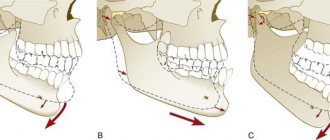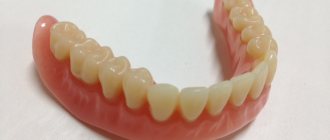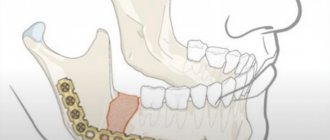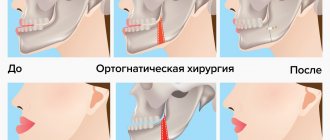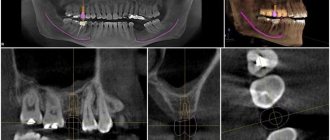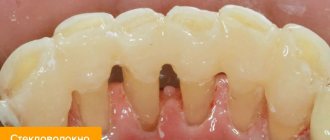It is generally accepted that beauty is expressive eyes, a straight nose and a high forehead. But it often happens that even a face with regular features seems ordinary.
This effect is also called the absence of “breed”, when the image is devoid of expressive lines and relief.
Expert comment:
“Have you ever wondered why many successful acting careers in Hollywood begin with correction of the chin and angles of the lower jaw?
The effect of "breed" and an expressive face is usually closely related to the shape of the cheekbones and lower third of the face. This is not always obvious, but it is they who form the general impression of harmony or disharmony of traits. That is why correction of the jaw, its augmentation, very often allows us to solve many appearance problems.”
Vasiliev Maxim, plastic surgeon.
Angelina Jolie
Tom Cruise
Our many years of experience in the field of appearance harmonization allows us to create an expressive jaw line that balances facial features, giving it the missing sculpture and breed.
We perform all procedures strictly after a series of anthropometric measurements and calculations, on the basis of which we individually select the size and shape of the implants. Only this approach allows you to not only make your jaw wider or narrower, but also get an attractive face on which even your worst friends will not find traces of surgical correction.
However, first, let’s figure out what is needed for a beautiful jaw.
What a beautiful jaw in men
Surely, when you hear the words “masculinity,” the first faces that come to mind are the Marlboro cowboy, Tom Cruise, or Sean O’Pry.
But if nature did not bother to develop a man’s chin area, then his appearance evokes completely different associations. Excessive softness, indecision, perhaps even weak character - these are the first impressions of a face with a small chin and soft lines of the lower jaw, even if their owner himself feels quite courageous and strong.
Expert comment:
“The reason for this perception lies in our subconscious.
Sex hormones are primarily responsible for how developed the bone structure of the lower jaw is. Protruding brow ridges, a strong-willed chin and a massive, square, well-developed jaw are testosterone traits. This is a sign of a healthy and strong man.
Such a man always attracts attention as a promising partner in his personal life and in business.
Enlargement of the jaw and chin brings the external appearance into complete harmony with the internal state of a person.”
Vasiliev Maxim, plastic surgeon.
History of the face. Workshop of physiognomic psychoanalysis
2.2. JAW PHYSIOMETRICS: FRONTAL AND GENETIC
It is dangerous to attack on a broad front, but there is a crushing chance of recoupment on the flanks.
Kozma Prutkov, corporal, “In imitation of von Clausewitz”
Be persistent, and your face will be called strong-willed.
Advice from a promoter for a dystrophic person
“If the face asks for a brick, then you also need to consult with the brick itself.”
Kozma Prutkov, “Communicative Confusions”
Now let's look at the lower jaw from the frontal position, i.e. in front of the face. In order to professionally diagnose its psychodiagnostic features, we will have to introduce two measuring physiognomic factors or criteria: jaw width and jaw length. In schematic figure 2.4. these are lines AB and CD, respectively.
DIAGNOSTIC PHYSIOMETRICS.
How to determine jaw width? Draw a transverse line at the level of the middle of the lower lip if the lips are thick or drooping, or directly under the lower lip if they are thin. This way you can accurately determine the width of the lower jaw. The purely visual method “by the nodules” (i.e., the lower attachment point of the masticatory muscle) is much less predictive, since the ligament of this muscle is attached to the lower jaw much lower. There are even fewer problems with “length” - again, take the middle of the lower lip as the starting point of reference and lower the perpendicular line to the lower point of the chin.
In fact, the lower jaw is a vault, which has a base (the width of the jaw) and a height (in our case, the length) because the vault is down. The massiveness of the jaw is determined precisely by its large width and large length, i.e., simply put, it is a powerful, almost triangular bone, which even if it “clicks” with its teeth, then... it will not seem small. That’s right, we all came from the primitive “veld”, where the force of impact and compression of such a jaw was by no means a sporting competition. Let's translate the indicated morphological features into the language of psychodiagnostics.
Jaw width is the ability to distribute force or external impact over as wide a radius as possible. A military analogy would be appropriate: a broad front. It has its advantages and disadvantages. You can encircle the flanks, but will the middle withstand a possible counterattack? Again, the girth or grip is carried out as completely as possible when the forces are evenly distributed over the entire vast perimeter, that is, massively. As a result, there is no point of ultimate tension, as well as a weak link. Everywhere and everywhere there is even compression and the ability to redistribute forces from the center to the flanks. What is usually meant by the concept of "mobility" or "mobility". This is exactly how a frog behaves, whose jaw is quite wide relative to its head during the evening hunt. Let us emphasize once again that the most important advantage of a wide jaw is the ability to work on the flanks, successfully redistributing one’s efforts. In genetic terms, we can hazard a guess that a wide jaw determines the strength of the nervous system for endurance or general performance. The second genetic factor at work here is the mobility of the nervous system, or, as they say now, mobility. This is, so to speak, in an abstract version, if there were only one dominant parameter - the width of the jaw. But we will still risk psychologically diagnosing this parameter - first of all, general performance, strength, mobility, mobility in delivering flank attacks, the ability to quickly switch. Let us add from everyday observations: people with a wide jaw are much calmer and more confident. They are less prone to hysteria and neuroses. Instead of signaling to the outside world “how bad it is,” they prefer to look for loopholes, maneuvers, or even “stupidly,” “wear and tear” to wear down the enemy. Oddly enough, a wide jaw is sensitive. That is, it creates the prerequisites for mobile response to signals from the external environment, but not in an attacking way, but more in a stabilizing or preserving way. Simply put, individuals with a wide jaw do not attack first. But they hold up extremely well. Provided that the length of the jaw is not short. In other words, a wide jaw should not be thin and light. That is, we again return to the resulting “width + length” scheme. But let’s finish talking about width and say a few words about a narrow jaw (see schematic drawings 2.5 and 2.6.
A narrow jaw is certainly more vulnerable to lateral displacement. In other words, a flank strike. She is in no way able to maintain a strong defense. Therefore, a person with a narrow jaw always prefers to turn sharply to face the enemy or other trouble. One way or another, he is always focused on the main direction. Hence the target orientation and commitment to one paradigm. Outwardly, behaviorally, this is sometimes perceived as perseverance, perseverance and even courage. But essentially, it’s just a compensatory reaction of a narrow-jawed individual to his own problems with the external environment.
Now let's talk about the second qualitative characteristic of the jaw - its length. A still elongated jaw can be called heavy, and a short jaw can be called light. Indeed, in essence, this is how it is. Schematic figures 2.7 and 2.8 illustrate the above. It is clear that a light jaw is more mobile and dynamic. Hence the corresponding psychological portrait of the individual: mobility, lightness, efficiency and agility. That is, at a minimum, the ability to quickly “switch on” and, in the same way, without a prolonged pause, “switch.” Let's add to this the high lability of nervous processes, or, in other words, the speed of reaction to a sudden signal. What we call “grabbing on the fly.” What it lacks in heaviness, the lightweight jaw makes up for with instant response and inertia-free switchability.
A heavy or long jaw, on the contrary, visually convinces with its thoroughness and methodicalness in matters and approaches. Such people most often work by “pushing through” the problem. A kind of “crowbar principle”, there is a hand-held device that ice fishing enthusiasts use to drill a hole. However, the association is relevant if the jaw is clearly elongated and narrow at the same time. But in general, the elongation of the striking bone creates the prerequisites for perseverance, determination and strength. That is, if the problem cannot be pushed through, then it must be split. A “heavy” jaw determines the genetic ability to withstand strong but short-term stress. If the individual manages to turn to face him. Not so much figuratively as psychologically.
A wedge is knocked out with a wedge. Or they arrange a counter battle with a “test drive” for strength. It is also possible to exert extremely stubborn resistance with increasing pressure on the opponent, but then the jaw must be not only elongated, but also wide. Therefore, to complete the psychodiagnostic picture, it is appropriate to briefly examine separately all four options, the relationship between the length and width of the lower jaw bone: a) the jaw is wide and elongated; b) the jaw is wide and short; c) the jaw is narrow and elongated and d) the jaw is narrow and short.
OPTION A:
THE JAW IS WIDE AND LONG. Shown schematically in Fig. 2.9. You can also say that it is wide and heavy, that is, massive. People also call it “bulldog”. As you know, bulldogs and boxers are quite phlegmatic dogs, but if they grab onto someone, they will do so with a death grip. The massive jaw lacks mobility and mobility, but is incredibly strong and resistant to stress attack. It is unlikely to be easily broken by either a very strong but short-term stressful blow or a very long and intense external influence. Feedback in such people is usually slow, as is the threshold of some sensitivity in moments of danger or trouble.
Their equanimity is precisely ensured by a strong jaw and a strong nervous system. They adapt to changes slowly, since they easily withstand the onslaught of the influencing factor. As a matter of fact, this same property can also be attributed to the “minuses”, since instead of the necessary adaptation, “strong-jawed” individuals habitually prepare for deeply echeloned resistance. It can be assumed that their reaction to danger is genetically somewhat slower. After all, if everything can be overcome, then what should we be afraid of? Actually, their courage is a kind of alloy of self-confidence and carelessness. Such an individual archetype is laid down from early childhood, when a strong jaw inspired involuntary respect from snotty peers. The physiognomic appearance itself convinced, and often nothing more was required. However, you didn’t have to dig deep into your pocket for evidence—persons with long and wide jaws don’t resort to demonstrative hysteria and neuroses. It’s better to go head-on. Hence the corresponding decision-making strategy in business and politics. Reflexiveness of response is replaced by indestructible persuasiveness. Imagine for a moment the image: a bulldozer on a narrow slippery mountain serpentine. Either the road will become smoother and wider, or look into the abyss. There are no immediate compromises. By the way, during the formation of a business there is a great need for such types; in the future they simply serve as a stabilizing factor. Until the moment when you again have to move with all your might.
OPTION B:
THE JAW IS WIDE AND SHORT, that is, light and mobile with good flanking stability. It is shown schematically in Fig. 2.10.
Most often, such people are closer to the round-headed type. They are easy-going, clearly mobile, most often cheerful and have no problems communicating. They very quickly rebuild their tactics and strategy, looking for the weakest areas of resistance from the external environment. They will prefer a bad peace to a good war. To some extent, the everyday rule applies to them: “don’t have a hundred rubles, but have a hundred friends.” True, always be prepared for separate negotiations. The weaker the jaw and the wider its “range”, the greater the desire to protect oneself with as many allies as possible. What the “light” jaw partly lacks is methodical punching power based on its own capabilities. But with adaptation and feedback, everything is as good as it can be. Do you want a clever and successful manager? Then this portrait type is just what you need. Not a single detail will be left unattended and at the same time nothing will be given more attention than it is worth. People with a wide but light jaw are not rigid and devoid of preconceived dogmatism. They will be able to adapt to the situation and will begin to actively look for new options. Even if they are not in the traditional sphere of their interests and habits. The mobility of transferring funds always helped them out. In such cases, people say: “If we don’t wash it, we’ll ride it.” The main thing is that a positive result is achieved, even if not in the format as originally intended. Neuroses and hysterics about the soaring crane in the sky are definitely not expected. Agree, this is also an undoubted advantage.
OPTION B:
THE JAW IS NARROW AND LONG, that is, narrow and heavy. Outwardly it resembles an impressive jaw “promontory” protruding towards the lobe (see Fig. 2.11).
Note: do not forget to measure the width and length of the jaw on a relative scale of the entire face, i.e. according to the ratio of proportions. In the schematic drawings, arrows indicate how this is done. A narrow and elongated jaw is characteristic of systemic people and very, very persistent people. Not only in actions, but also in institutional desires, plans, goals, priorities, etc. Such individuals achieve their goal at all costs, until their strength completely runs out. They are real “miners” and will diligently chisel away at intractable rock. If we add will and patience here, the result may turn out to be predictable. In their favor. Disadvantage: inability to get distracted and get out of the self-defined template system. Hence the great overload of the nerves, heart and musculoskeletal system. If victory is not achieved as expected, deep stress is very likely. Instead of adaptation, there is an attempt to subjugate the environment and impose its own rules of the game on it. Moreover, failures at the initial stage only provoke “long-jawed” individuals and give them motivation to be even more persistent. Maybe that’s why they make very good crisis managers. And in general, in management they profess the cult of a tough leader, endowed with charisma to achieve the impossible. As a result, there is a danger of developing megalomania and the disease of success. With chronic failures, paranoid tendencies may appear - “who is to blame and why have you been unlucky for so long?” But even in this case, the elongated jaw, instead of neurotic tearful complaints, will provoke its owner to once again deliver an echeloned frontal strike in order to finally break through to the coveted paradise. What is more, the ability to concentrate efforts at the right moment in one decisive direction is not lacking for individuals of this jaw type.
OPTION D:
The JAW is NARROW AND SHORT, in other words, light and selectively purposeful. It is also usually called “triangular” (see Fig. 2.12).
It certainly does not have massiveness. But it has its own advantage: dynamism and concentration of efforts at one point of application. This is exactly how the tank wedges of the German Wehrmacht operated in the first period of World War II before they had heavy and super-heavy tanks. Purposeful advancement in narrow areas with extraordinary speed of maneuvering against serious frontal resistance. Armies behave like people, and each has its own style and character. The narrower the triangular jaw, the stronger its composure and concentration on the chosen target. The lighter it is, the greater the dynamism and mobility in transferring efforts from one local fragment to another. In fact, in this case we are dealing with a “point” application of effort. In the animal world, representatives of the mustelidae family, small but very bloodthirsty mammalian predators: martens, ferrets, weasels, badgers, have such a very mobile, lightweight jaw. It is better not to get caught by even smaller animals in their sharp teeth - there is almost no chance of becoming “game”. By the way, cats are the eternal and irreconcilable enemies of mustelids; they have a wider jaw, but also lighter. The fight between them is short and somewhat reminiscent of lightning-fast karate for a fatal defeat. But in general, for these fluffy and seemingly cute predators, the highest selectivity in attack is fundamental. People, even if this may not seem offensive to some, have something similar. The narrower and lighter the jaw, the more carefully you need to prepare for the fight. The more specific the methods and techniques. The behavior of a person with a narrow and light jaw still resembles the actions of light cavalry in past eras of hand-to-hand wars. A quick attack, search for a weak point, maneuver, choice and another, almost lightning-fast attack. Individuals of this physiognomic type are most afraid of getting bogged down in a long frontal confrontation, in which the flanks are pinned down and only the more resilient and persistent can win. In the same way, they are completely reluctant to expose themselves to a powerful and crushing stress blow - the jaw is not that strong. But who can say that against the “Goliath” there will not be a “David”? Dexterity versus strength also has a chance of winning.
And even a relatively small shock, if it is at the point of application of tension, can give rise to an avalanche. “Weak-jawed” individuals are able, like no one else, to deliver effective “acupuncture” blows. What can you do, such is their genetic advantage. Maybe that’s why they advance quite effectively in business as referents, analysts, and office managers, very quickly reaching the level of first deputy bosses. High sensitivity to danger or threat signals, as well as productive feedback, allows them to provide useful information to their boss before anyone else. In a word, the chances of achieving a career for “weak-jawed” individuals are perhaps the most promising. Unless society is stormed to such an extent that it will be necessary to survive with strength and strength alone. However, you can also lay a fairway as a team.
What a beautiful jaw a woman has
The structure of a woman's face has its own characteristics. In order to look beautiful and graceful, a woman needs chiseled cheekbones and a smooth jawline.
Despite the widespread dictate of Angelina Jolie's image, the convex angles of the lower jaw and protruding chin are a manifestation of masculine traits. A feminine jawline should be smoother, yet firm and well-defined.
To make the image refined and sophisticated, too pronounced angles of the lower jaw require delicate grinding of the bone tissue.
Jaw correction may be accompanied by chin augmentation and removal of Bisha's lumps to enhance the cheekbone line. These procedures allow you to tighten the skin under the chin, get rid of the double chin effect, and create a beautiful line of the chin-cervical angle.
Renaissance and plastic surgery
So, how do you understand that the lower third of the face is underdeveloped and needs correction? Take a full-face photo of yourself and mentally or with a pencil, divide your face into three parts horizontally. The upper third of the face is from the line of the nose to the middle of the eyebrows, the middle third is from the middle of the eyebrows to the tip of the nose, and the lower third is from the base of the nose to the chin. Now take a ruler and measure these three parts.
In a harmoniously beautiful face, the distance from the hair growth to the eyebrow line, from the eyebrow line to the base of the nose and from the base of the nose to the chin is approximately the same.
Even Renaissance artists showed that on a proportional face these three parts are equal. If one of them is significantly larger or smaller than the others, the face is perceived as inharmonious.
Improved bite
| Well a few words about the bite. After all, these operations were originally conceived to solve such problems. To obtain the correct bite, first orthodontic preparation was carried out, which consisted of aligning the dentition and creating a gap between the upper and lower incisors, which I needed as a surgeon for maximum advancement of the upper jaw forward. As a result of the operation, the bite became correct and the smile became beautiful. Many thanks to orthodontist Elena Nailievna Ismagilova! |
Non-surgical correction of the angles of the lower jaw with fillers
Is it possible to increase the angles of the lower jaw without surgery? If the bone deficiency is minor, we suggest trying fillers in the lower jaw.
Temporary increase in the angles of the lower jaw with filler.
Performed: upper blepharoplasty, ️installation of a chin implant, medial and lateral platysmaplasty with neck lift through an incision in the earlobes.
Performed by a surgeon - Maxim Vasiliev .
At Platinental we use Voluma, Radiess or Juvederm fillers for this purpose - they are quite dense, safe and create the desired contour for a long time.
The main disadvantage of increasing the angles of the lower jaw with fillers is that the effect is temporary: the gel is completely absorbed, and after two years the fillers will need to be reinjected.
However, this procedure can be considered a rehearsal. If you like the result, it makes sense to consider permanent correction of the angles of the lower jaw with implants.
Jaw contouring with permanent implants
A much greater effect will be achieved by increasing the angles of the jaw using porous Medpor implants.
Expert comment:
“Medpor is a very dense porous biomaterial that has been known in plastic surgery for more than 30 years.
Medpor is ideally compatible with tissues and does not require special fixation to the bone. It grows with connective tissue and blood vessels and literally becomes “one” with its own bone tissue.”
Andrey Iskornev, plastic surgeon
We always start with careful planning of the operation. Our task is not just to build up the lower jaw, we look at the issue much more broadly and our goal is to create a beautiful, harmonious face. Enlarging your lower jaw should improve your appearance.
Therefore, in addition to experience in plastic surgery, the doctor must have artistic taste and an analytical mind.
All jaw angle implants are always selected individually in accordance with the concept of appearance harmonization. In difficult cases, a stereolithographic model of the skull is performed to plan the operation and select implants.
How is plastic surgery of the angles of the lower jaw performed?
After planning the implant, it is time for surgery. It lasts about an hour under general anesthesia. We usually use intraoral access, so there are no stitches on the face after surgery.
Of course, jaw augmentation surgery, like any plastic surgery, requires time for rehabilitation. The recovery period lasts about two weeks, and for the first few days you will have to wear a bandage that helps stabilize the implant.
Subsequently, there is no danger of it migrating: the pores of the material from which the implant is made grow with connective tissue so that the implant simply grows into the bone tissue. The implant is installed once and for life, does not require replacement.
Features, methods, stages of treatment
The choice of correction method is influenced by the patient’s age and the degree of pathology.
Correction of mesial bite in children
The best period to correct any malocclusion is childhood. It all starts with a massage of the alveolar processes, then:
Myogymnastics
- for the little ones, up to 5-6 years old. Special oral exercises will allow the jaws to grow harmoniously. For older children, myotherapy is prescribed in addition to the main treatment.
Trainers
for patients 5-8 years old they help correct the bite. For 4-8 months they are worn at night. It is a silicone two-jaw mouth guard. Acts on the jaw muscles.
Plate
. From 8 years old, an orthodontic plate is offered. Plastic base with metal arches correcting mesial occlusion. There are many types and modifications: Frenkel activator, Bruckle apparatus, Andresen-Goipl Activator, etc. The choice of whether it will be a classic plate, with springs or another depends on the degree of pathology.
Orthodontic cap
. The child will have to stay in it for 6-8 hours. It looks like a corsage with elastic bandages that puts tension on the back of the head and chin.
Bracket systems
. Mesial bite can be corrected with braces from the age of 12. The structure is not removable. The impact of a metal arch with brackets on the teeth and jaw is constant. They wear it for about a year.
Braces with and without ligatures to correct bite
Treatment of mesial occlusion in an adult
For adults, treatment begins with braces or inexpensive orthodontic plates. But they will have to be worn twice as long as children. Since it is not always possible to correct a mesial bite without surgery, implantation and prosthetics are sometimes necessary.
In case of severe pathology, it is necessary to resort to surgical intervention. There are 2 types:
- gentle
_
For effective correction it is necessary to remove the teeth
. - traumatic
_
This is an operation
directly on the jaw. Its excision and forced fixation of the correct position using a structure made of titanium plates and screws. Stitches and plaster splints are applied and must be worn for 2 weeks. To consolidate the result, either braces or retainers are used.


